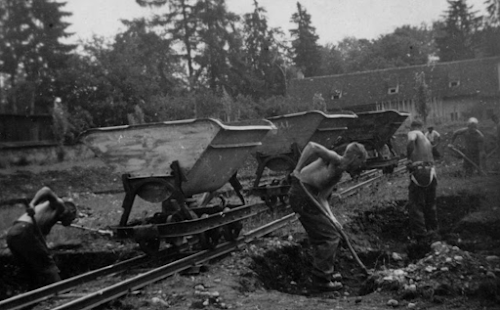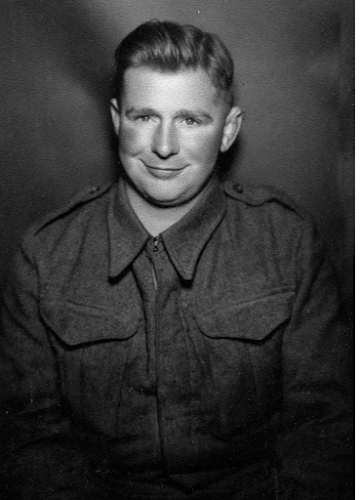The Klagenfurt Camp was built by wealthy construction contractor, Adolph Rabaul, a relative through marriage to Adolph Hitler. It occupied an area of about five acres in the suburb of Waidsmandorf. Barracks lined two sides of the perimeter, each with six rooms referred to as huts. Each hut contained bunks for up to 20 men, two tables and a pot belly stove. The camp was built for 240 prisoners. The third side was the kitchen (called the cookhouse) and a mess hall. In the middle of the compound was an ablution block with cold showers and wash troughs. A 10-hole septic tank occupied the fourth side of the camp.
The camp itself was surrounded by a double barbed wire fence.
There were four watchtowers equipped with searchlights. Another building was
the camp hospital which was equipped with 12 bunks. The German guards were
quartered in a building at the camp’s entrance. There was an adjacent POW camp
that he French prisoners of war. I am unaware if there was any fraternisation
between the French and Allied soldiers, but I known that prisoners from both
camps worked together on at least one work party, the one the one where Michael
Cister lost his life in 1944.
The above information was extracted from Kevin Byrne’s memoir which also included a sketch of the camp layout from which I constructed the diagram below.
While the work
camp was home to 10029/GW Allied POWs it also housed POWs on other work party
contracts from time to time (possibly even for the duration). Men from 10066/GW was
one such group.
The POWs in the
Klagenfurt camp were deployed on Adolph Rabaul’s contracts, but sometimes were sub-contracted
to other contractors. Kevin's work party was digging
foundations and trenches by hand with a shovel. He called this “swinging the
banjo.” He also did snow clearing, pipe laying, and unloading coal at the local
railway junction. His last job was on a furniture removalist's van. And of
course, like most of the men who interacted with the local population, Kevin became fluent in the German language.
Profiles
Known as Charlie, he was born in Port Macquarie, New South Wales, on 27 Nov 1913. Charlie was a driver with the Australian Army Service Corps. He died in Sydney on 4 Aug 1979 aged 65.
A file on Charlie's service records contains the following quote: "German troops split us and shot the Greek help I had." In the escape, Charlie said he was accompanied by 'Frank' Hickey. This man was Ronald Francis Hickey, a fellow member of the Australian Army Service Corp. Frank was killed on 18 Oct 1941. Charlie's daughter said that "he was on the run and in hiding from the Germans and the Bulgarians in the north of Greece ... where he witnessed atrocities committed against the Greek people. Up in the hills in the north of Greece he had incredible support from some villagers, who were hiding and feeding him at great risk to themselves."
Charlie was among the prisoners who were marched to Stalag 18C at Markt Pongau in March and April 1945. Markt Pongau was in the Salzburg redoubt, 168 kms north of Klagenfurt.
Ian Lipsett was born 1 Sep 1915 in Albury, New South Wales. He lived at Jindera, a small town on the city's outskirts. He enlisted in the Army at Wangaratta, Victoria. He was an infantry soldier with the 2/8 Battalion. Postwar, Ian married and lived in Port Kembla, NSW. He died in Woolongong, NSW on 3 Jan 1991 aged 75.















No comments:
Post a Comment